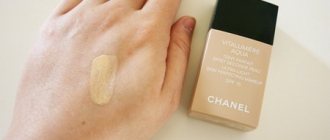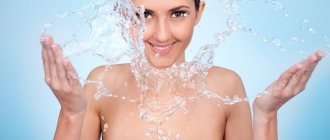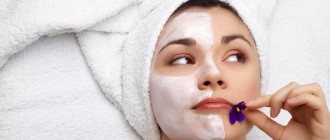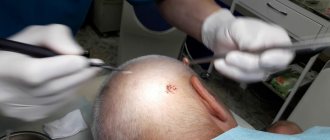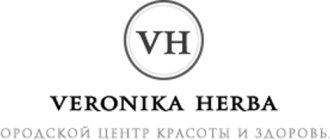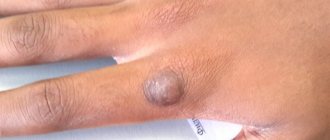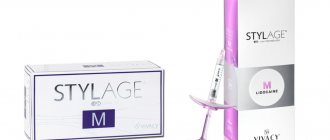Solar radiation benefits the body by stimulating the production of vitamin D, but in large doses it has harmful effects on the skin. A common result is sunburn, destruction of cell DNA and collagen fibers, itching, the appearance or deepening of wrinkles, excess pigmentation, and skin cancer can also occur. Special products marked SPF are designed to prevent or reduce the negative consequences.
Decoding the abbreviation helps you understand what SPF is in cosmetics (Sun Protection Factor) - this is the sun protection factor of emulsions, creams, lotions, oils or sprays. They block UVB radiation . Products that resist both types of sunlight are labeled “broad spectrum” or labeled UVA/UVB .
SPF protection: what is it?
SPF (or Sun Protection Factor)
– protection factor against UV radiation, and the higher its value, the more effective the protection. There are two types of ultraviolet rays that have a negative effect on human skin - UVA and UVB rays.
- UVA rays
make up 95% of all ultraviolet radiation reaching the earth's surface and are the most dangerous for the skin. They are the ones who trigger the process of destruction of collagen and elastin, damaging dermal cells, eventually provoking malignant changes and promoting photoaging. UVA rays penetrate clouds and glass all year round and even in winter can have a detrimental effect on the skin, promoting the synthesis of free radicals. - UVB rays
make up only 5% of all ultraviolet radiation reaching the earth's surface: most of them are blocked by clouds and glass. UVB radiation penetrates the epidermis, causing the skin not only to tan, but also to get a sunburn, which can trigger an allergic reaction or the development of cancer cells.
Answers on questions
Cream with SPF and vitamin D
If we use cream with SPF, then how does the vitamin D that we need so much get into our body?
Vitamin D does not enter, but is synthesized in our body under the influence of ultraviolet rays. But no cream with SPF provides 100% protection from the sun, and in addition, in the summer our arms and legs are left exposed.
This way, you will still receive the necessary dose of ultraviolet radiation for the synthesis of vitamin D. To do this, it is not at all necessary to lie on the beach for hours, but rather a walk in the park or on the way to work.
Using products with different SPFs at the same time
And if you apply cream with SPF 30 and powder or foundation 15 on top, what kind of protection will there be?
SPF is never cumulative. In the best case, a product with SPF with higher protection will work. But there are times when the product can reduce protection.
For example, if a girl applied cream with SPF 20, and then applied foundation with SPF 10 on top, then it is quite possible that it will slightly dilute the previous cream and the protection will no longer be 20, but slightly lower, for example 15.
How to renew SPF cream in extreme conditions
How to renew cream with SPF while traveling in the desert or in the mountains when there is no access to a washbasin? Or maybe it’s better without cream at all?
If you were not born and raised in the jungle, then you still better use sunscreen. And updating it is quite simple. You probably have a bottle of drinking water with you and you can simply wash your face, pat your face dry and apply a new portion of cream.
And if there is not even water, then you can take wet wipes with you and wipe your face with wet wipes, remove the cream that you applied a few hours ago and apply a new portion of cream.
Sun protection without SPF
In everyday life, we apply a fair amount of decorative cosmetics to our skin; they do not always contain SPF, but the question is: don’t the layers of cosmetics themselves create mechanical protection from the sun on the surface of the skin?
It’s absolutely true that any high-quality cream has a base that in itself protects our skin from the harmful effects of the environment, including the sun.
This is why young skin, which still produces enough of our own cream, is better protected from the sun than mature skin after 35-40 years.
How much cream to apply to face and neck
Many sources recommend applying 1/4 teaspoon of sunscreen to your face and the same amount to your neck. But what if it’s foundation with SPF or powder, because that amount will be too much?
You need to understand that these recommendations apply primarily to long stays in the active sun - when you are on the beach, on a boat trip or on an excursion in hot countries. Because when you swim, wipe off sweat, or lie on a towel, you lose some of the protection.
In this case, in order to provide the skin of the face, neck and décolleté, and the whole body, with reliable protection, you need to use a cream with a high SPF and you really need to apply it to the skin in large quantities without saving.
And it shouldn’t be a foundation, it should be a regular sunscreen. But if we are talking about everyday life, then most people go to work in the morning, return in the evening, during the day they go out for a maximum of 10-20 minutes in a cafe for lunch, that is, they practically never spend time in the active sun.
Plus, don’t forget that women very often apply several layers of SPF products to their facial skin. Day cream with SPF, foundation or BB cream with SPF, and powder on top.
And although SPF is not cumulative, and the degree of protection will be determined by the product with the highest SPF, these layers themselves will still provide you with more reliable protection. So in the city you shouldn’t worry about this and apply plenty of sunscreen.
Why is sun protection so important for your skin?
Sunscreen will help minimize the negative impact of UVA and UVB rays. Cosmetics with SPF, like a mirror, reflect the sun's rays and prevent their destructive effects.
Prevents not only sunburn, but also other undesirable consequences:
- photoaging;
- the appearance of allergic dermatitis;
- the appearance of sunburn;
- development of malignant changes.
Exposed areas of skin, mainly the face, must be protected from ultraviolet radiation all year round. During the day, use a cream with SPF, which will prevent photoaging of the skin: dryness, the appearance of premature wrinkles and age spots, decreased firmness and elasticity, rosacea.
According to cosmetologists, in 70% of cases, the skin ages precisely due to exposure to ultraviolet radiation. This is due to the fact that ultraviolet radiation penetrates the dermis (deep layer of skin) and promotes the formation of free radicals that have a destructive effect on collagen fibers.
SPF creams perform important functions:
- protect against burns without interfering with the appearance of a tan;
- prevent the appearance of pigmentation, spider veins, and malignant neoplasms;
- moisturize and nourish the skin, saturate it with vitamins, give elasticity;
- preserve youth, freshness and beauty of the skin;
- restore and renew the skin.
ATTENTION! Clothing guarantees the prevention of burns, but not photoaging. It is better to cover even a body covered with a cloth with a layer of sunscreen.
What levels of SPF protection are there?
The degree of protection against UVB radiation, which causes sunburn, is considered to be the numbers indicated next to the abbreviation SPF:
- SPF 10 blocks less than 90% of UVB rays;
- SPF 15 – 93%;
- SPF 30 – 97%;
- SPF 50 (+) – 98%;
- SPF 100 filters up to 99%.
There are 2 types of SPF filters:
- Physical
(mineral): titanium dioxide (titanium dioxide) or zinc oxide (zinci oxydum) are the most common existing ones. They work as a protective screen that reflects the sun's rays from the surface of the skin. Suitable for sensitive skin (including children's skin). - Chemical
(oxybenzone, octocrylene, mexoril, etc.): absorb UV radiation, becoming more active under their direct influence. Some chemical filters are effective against the negative effects of UVA rays, and some are effective against UVB rays.
Modern manufacturers often combine both types of filters in formulas to protect the skin from a wide spectrum of radiation.
My Favorite Sunscreen 2022
Last spring I first tried the new VITABRID cream - C12 ALL-DAY UV Defense SPF 50+, and have been using it for a whole year.
The cream contains ONLY physical filters, which completely eliminates harmful effects on the body. Protects against spectrum A and B rays. Maximum protection level: 50+ and PA++++.
In addition, the cream contains stabilized vitamin C and provides antioxidant protection.
For readers of my blog there is a 10% discount on orders of all Vitabrid products.
How to choose the right products with SPF?
To choose a suitable sunscreen, first of all, determine your phototype, then what auxiliary functions the sunscreen should have: moisturizing, nourishing, mattifying the skin, etc.
Determining skin phototype
The phototype determines the degree of skin reaction to exposure to UV radiation and directly depends on its natural ability to protect itself from it. Any skin, when exposed to sunlight, produces the pigment melanin, which affects its natural shade - this is the main evaluation criterion.
There are 6 phototypes:
- Phototype 1 (Celtic, albinos)
– very light skin (milky white, porcelain), high sensitivity to ultraviolet radiation: reacts to the sun with redness, rarely tans, often covered with freckles. For this phototype, use products with SPF-50+. - Phototype 2 (Nordic, Scandinavian, Aryan)
- light ivory skin, often with freckles, often burns in the sun, a light tan rarely appears. For this phototype, use products with SPF 30-50. - Phototype 3 (European)
– slightly dark skin, practically does not burn, tan appears gradually and evenly. For this phototype, use products with SPF 20-15. - Phototype 4 (Mediterranean)
– olive-colored skin without freckles, burns minimally, tan applies evenly and develops intensely. For this phototype, use products with SPF 15-10. - Phototype 5 (Indonesian)
– dark or dark brown skin, rarely burns, tan appears as a rich dark shade. For this phototype, use products with SPF 10-5. - Phototype 6 (African)
– very dark chocolate-colored skin, low sensitivity to ultraviolet radiation: never burns, very dark tan. For this phototype, use products with SPF 5.
Composition of Sanskrins
In addition to physical and chemical SPF filters, the basis of the sunscreen formula may include moisturizing and softening components (thermal water, glycerin), mattifying components (salicylic acid and niacinamide), antioxidants (Selenium, Baicalin, vitamin E), etc.
The composition of the product depends on the skin type for which the protection is intended.
Additional functions
It also depends on your skin type what additional properties Sanskrin should have. According to its characteristics, the formula of a product for sensitive skin will differ from the formula for oily and problem skin types.
To maintain the beauty and health of your skin, choose SPF protection based on the needs of the epidermis:
- Oily type
: light texture products (fluid, milk, cream gels) with mattifying (sebum-regulating) non-comedogenic formulas and anti-inflammatory properties. For this type, it is not recommended to use tanning oil, which clogs the pores. Anthelios SPF 50+ sunscreen gel cream for oily, problematic and acne-prone skin or Anthelios SPF 50+ tinting fluid from La Roche-Posay are suitable. - Dry type
: non-greasy creams or oils with moisturizing and softening formulas. Light spray milk Anthelios XL SPF 50+ or invisible spray veil for face and body Anthelios SPF 30 from La Roche-Posay are suitable. - Sensitive type
: light textures (milk, cream-gels) with hypoallergenic formulas and a calming effect. To protect the delicate area around the eyes and lips, also choose sunscreens for reactive/hypersensitive skin, for example, Anthelios Ultra Face Cream SPF 30, SPF 50+ from La Roche-Posay.
How to choose sunscreen
How to choose the sunscreen that's right for you? To do this, you need to take into account several factors:
- Your age
- Lifestyle
- Skin condition
- Ultraviolet index in your region
As you probably already guessed, it is almost impossible to give universal advice for everyone.
Since I live and work in Kyiv, I am primarily interested in the situation in Ukraine. Therefore, I will give recommendations that are suitable primarily for residents of Kiev and residents of most other cities of Ukraine, as well as residents of countries with a similar climate - for example, Russia and Belarus, where the situation with the ozone layer and ultraviolet index is approximately the same.
Well, if you live in America, Australia, Thailand, Israel or Spain, you better consult with local specialists or study the situation in your region yourself.
Ultraviolet Index (UVI / UV Index)
Ukrainians are lucky - in our country the situation with the ozone layer is better than in many other countries and the ultraviolet index is not very high. In the autumn-winter period, when we wear hats, UGG boots and gloves for six months and only our faces are exposed, using sunscreen with a high SPF is not only impractical, but also harmful.
Because in this case, you will experience a lack of ultraviolet radiation and get the very problems you hope to protect yourself from - decreased synthesis of collagen, vitamin D and, as a result, skin aging, brittle bones and bad mood.
To determine the ultraviolet index, and accordingly the required degree of protection in your region, you can use the convenient website nesgori.ru.
For example, today, the ozone layer in Kyiv is good, and the ultraviolet index is low - 3. And these readings are expected at midday. On a day like this, do I need intensive protection in the morning on my way to work? Like a hare, you need a fifth leg.
But if we check Sydney, for example, we will see that the situation there is completely different - the ozone layer is thinner and the ultraviolet index is higher. In general, if you suddenly live in Australia, now you should use high-protection products every day, and in addition, it is better to stay indoors during the midday hours.
ps If you use a smartphone, then your weather application probably displays up-to-date information about the current UV index. In the iPhone app it looks like this:
Age
In addition to place of residence, age is of no small importance - young and mature skin up to 30-35 years of age is protected from the sun much better than at an older age. So with age, protection needs to be strengthened.
Lifestyle
And of course, you need to take into account your lifestyle. It’s one thing if you’re an office worker and spend all day indoors, and another thing if you’re a young mother and walk with a stroller all day.
How to properly use cosmetics with SPF?
At first glance, it may seem that there is nothing complicated in using sunscreen, but even this process has its own nuances, which, if not observed, will reduce the effectiveness of the product with SPF.
Let's look at what mandatory steps include care that protects the skin from UV radiation and prolongs its health:
- Apply sunscreen 20-30 minutes before going outside so that the product has time to absorb and form a protective film on the skin.
- Apply a generous amount of sunscreen evenly to all exposed skin, including your décolleté, ears, lips, hands, and parting (the open strip of skin on your scalp).
- Update your protection every 2 hours. If you are relaxing on the beach, then reapply the cream after each swim.
- Always wash off any remaining sunscreen after exposure to the sun.
Contraindications to the use of SPF products
If there is irritation, redness and skin diseases, the use of products with SPF is undesirable.
It is unacceptable to use sunscreen if you are allergic to the ingredients in the cream. Do not replace SPF with skin care cream.
During pregnancy, you should avoid SPF products containing parabens, phthalates, formaldehydes, toluene, dihydroxyacetone, aluminum chloride and chemical sunscreen filters.
CAREFULLY! When applying SPF sprays, there is a danger that not all areas of the skin will be evenly covered. They are also strictly prohibited for use by children and people with respiratory diseases.
Review of cosmetics with SPF from La Roche-Posay
Sun protection moisturizing milk for face and body SPF 30/PPD 23
ANTHELIO
Sunscreen moisturizing milk
High degree of protection against UVA and UVB rays. Very waterproof formula. Moisturizing, melting texture, non-greasy, non-sticky.
RUB 1,549 more details
Sunscreen milk for face and body SPF 30/PPD 23
ANTHELIO XL
Sunscreen milk
Formula with low content of chemical filters. High degree of protection against UVA and UVB rays. Very waterproof formula. Moisturizing melting texture.
RUB 1,596 more details
Sunscreen moisturizer for face and eye area SPF 50+/PPD 35
ANTHELIO
Sunscreen moisturizer
High degree of protection against UVA and UVB rays. Very water and sweat resistant formula. Helps prevent oxidative stress caused by IR radiation and air pollution.
RUB 1,679 more details
Choosing a sunscreen
When choosing a sun protection product, you need to take into account the following factors:
- With age, the protective abilities of the skin decrease, therefore, upon reaching the age of 30, it is recommended to choose lotions with a higher index.
- The UV index of your region and the period of highest solar aggressiveness during the day should also not be discounted. The closer to the equator, the more dangerous and destructive UV radiation is for the skin. The sun is at its most harmful from approximately 10 am to 4 pm; if possible, you should avoid exposure to its rays or increase the degree of protection.
- People with dry or heavily pigmented skin, or after undergoing a peeling procedure, should opt for SPF with a higher protection factor.
Examples
As an example, I sent 3 simple emails using telnet and SMTP commands. 2 letters will show the operation of the SpamAssassin spam filter (service mail-tester.com), and the last letter will pass the Gmail anti-spam filter. For the purity of the experiments, I used a “clean” IP address (finding it was not so difficult) and text without links and HTML.
| # | From | To | Result | SPF of the sender's domain |
| 1 | [email protected] | *@mail-tester.com | Successfully. Points at mail-tester.com: 7/10 | — |
| 2 | [email protected] | *@mail-tester.com | Unsuccessful. Points at mail-tester.com: 2.1/10 | v=spf1 include:_spf-a.microsoft.com include:_spf-b.microsoft.com include:_spf-c.microsoft.com include:_spf-ssg-a.microsoft.com include:spf-a.hotmail.com ip4:147.243.128.24 ip4:147.243.128.26 ip4:147.243.1.153 ip4:147.243.1.47 ip4:147.243.1.48 -all |
| 3 | [email protected] | *@gmail.com | Successfully | — |
Letter No. 1:
Letter No. 2:
Letter No. 3:
As can be seen from the results, an email from the domain “microsoft.com” would not pass the anti-spam filter, even if it had perfectly clean content. But the letter from the domain “microsoft.ru” was checked by both SpamAssassin and Gmail, since it is not protected.
All about the sun's UVA and UVB rays
In order to understand which product is right for you, you need to understand a little about the nature of the sun's rays.
The radiation that comes from the sun comes in 3 spectrums. These are A (UVA), B (UVB) and C (UVC) rays. Each of them is dangerous in its own way. Our body is affected only by A and B rays. UVC radiation does not pass through the ozone layer.
Now let's look at the negative consequences each radiation brings.
- A - these are the safest rays. Thanks to them, we get that desired bronze tan. However, when UVA rays affect the skin, they dry it out greatly, causing wrinkles and freckles to appear, and the aging process of the skin begins. Sometimes this radiation causes sun allergies.
- B – carries an average level of threat to the human body. These rays trigger the production of melanin, which protects the skin from burns. Excessive sun exposure can cause UVB radiation to cause burns, itchy skin, blistering and the formation of cancer cells.
- C is the most dangerous radiation. It causes cancer.
Before purchasing cosmetic products, pay attention to the labeling. Give preference to products with the UVA / UVB . This means that the selected cream, lotion, spray, etc. will protect your skin from A and B radiation.
Types of UF protection
Different sunscreens have different properties. It is thanks to these qualities that they are divided into the following types.
SPF factors with physical impact
The cosmetics contain titanium oxide and zinc dioxide, which reflect sun particles. They act as a kind of screen that prevents rays from penetrating the skin.
Cosmetics with this factor have a low level of protection, almost never cause allergic reactions, but are not waterproof.
SPF factors with chemical effects
These are products containing components that block rays by reacting with them.
Creams and other products with this action factor are highly effective because they contain a high degree of SPF. But they have a significant drawback - frequent allergic reactions to the components.
Natural SPF filters
These are components of plant origin that are used to make children's cosmetics.
These factors act only as an addition to factors with physical or chemical effects. They can improve the actions of other components.

